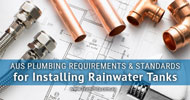
Water authorities in Australia are tasked with delivering high-quality water that is safe to drink and use in cooking. To ensure water safety, property owners need to comply with certain requirements and stands when installing or plumbing in alternative water supplies like rainwater tanks. This article examines general requirements and standards when plumbing in a rainwater tank to meet high water quality standards set by the health departments.
Plumbing Requirements
When installing and plumbing in a rainwater tank and connecting it to supply outlets within a property, Australian Standards AS/NZS 3500 specifies the minimum plumbing industry standards for water supply systems from rainwater tanks and must be complied with.
Plumbing requirements generally fall into the following categories:
- Connection requirements: where rainwater is used for toilet flushing, an automatic or manual interchange device that switches between rainwater and the mains water supply must be installed to ensure a continual supply of water.
- Fitting requirements: standards that specify requirements for tank fittings, adaptors and connectors for use with pipes and tubes in water supply (for example, AS 3688 Water supply – Metallic fittings and end connectors).
- Piping requirements: requirements of pipes for the delivery of your water under pressure (for example, AS/NZS 4130 Polyethylene (PE) pipes for pressure applications).
- Backflow prevention requirements: having an appropriate backflow prevention device to stop any water being able to flow back into the mains water grid.
- Licensed plumber and certification: plumbing attached to piping systems and connected to mains water supply must be installed by an appropriately licensed plumber who can produce a certification certificate of their work.
Backflow Prevention
The most important issues Councils and water authorities are generally concerned about with rainwater tanks, is preventing backflow of your water in the mains water supply. As such, property owners are made responsible and can be fined for not ensuring the correct backflow device is installed.
Where rainwater is going to be used within the home, it is recommended that an interconnection is made with the mains water supply. This interconnection means you need to ensure containment backflow requirements are met. According to the AS/NZS 3500:1 standard:
- An appropriate backflow prevention device must be installed at the main water meter assembly to protect your rainwater tank supply from flowing back through the water meter.
- Zone or individual backflow prevention devices should be installed throughout the property to protect the drinking water supply from water servicing toilets.
- A rainwater to mains water switching device should be installed, allowing switching between the use of tank water or mains water supplies. This ensures a constant supply of water you’re your rainwater supply is low.
- Where your water tank is completely or partly buried and plumbed in, the potential for water contamination increases. This requires a testable backflow prevention device that is rated for high hazards to be installed.
- Containment testable backflow prevention devices must be registered with your water authority prior to use. Devices must be tested annually by a suitably qualified plumber and a copy of the test report provided to the water authority.
Team Poly tanks offer you a very wide variety of water tank models to choose from, whether you’re after a traditional round tank, a more unique Boabab tank, slimline tank or an underground tank. Talk to us today, we’d be happy to assist you with making the right decision.

